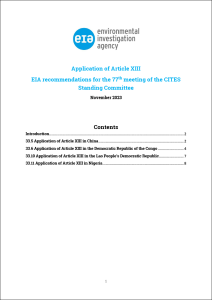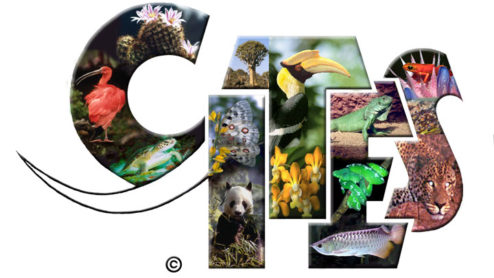Asian big cats
Application of Article XIII in Laos
 The CITES compliance process is taking place in relation to Laos for, among other reasons, its failure to control and phase out tiger farms in the country, which the Government had committed to convert to zoos in 2016.
The CITES compliance process is taking place in relation to Laos for, among other reasons, its failure to control and phase out tiger farms in the country, which the Government had committed to convert to zoos in 2016.
Based on a mission to the country, the Secretariat has raised serious concerns about the power of the Laotian authorities to conduct inspections of captive tiger-facilities. Laos has also not been able to demonstrate compliance with other long-standing Standing Committee recommendations, including on fundamental issues such as national legislation to implement CITES.
The Secretariat has highlighted that very limited efforts are being taken to combat illegal wildlife trade in the country, despite significant support being provided. EIA will be encouraging the Standing Committee to adopt the Secretariat's recommendation to suspend commercial trade in CITES-listed species with Laos and the other recommendations in paragraph 38 of SC77 Doc. 33.10, with suitable amendments to ensure that any captive breeding of identified pure specimens of Indo Chinese tigers is not conducted by the current captive tiger facilities which have links to criminal enterprises.
CITES Big Cats Task Force
SC77 Doc 39.3 presents the outcomes of the CITES Big Cats Task Force meeting held in Entebbe from 24-28 April 2023, in which EIA participated.
EIA supports the adoption of the recommendation in paragraph 10.b of the document encouraging implementation of the task force outcomes by affected Parties. However, we will be urging the Standing Committee to reject consideration of a common CITES resolution for all big cats as it is premature at this stage.
The current ABC resolution (RC 12.5) applies to only Appendix I species and contains recommendations on subjects such as domestic markets, stockpiles and eliminating use of parts and derivatives in traditional medicines. It is not clear how these recommendations will apply to an Appendix II species such as lions nor whether a common resolution will result in dilution of these recommendations.
A common resolution for big cats would also necessarily first involve agreement on what recommendations are appropriate for jaguars, cheetahs and lions, given that none of these species have specific resolutions applicable to them.
The Secretariat's report on ABCs
In SC77 Doc. 41.1, the Secretariat reports on implementation of the ABC resolution and associated decisions except for the matters relating to ABCs in captivity, for which there is a separate document.
Disappointingly, only nine Parties – including five Asian big cat range States – responded to the Secretariat’s notification seeking the relevant information. Some of the responses by Parties are contradicted by information that is well known and readily available. For example, China's assertion that it tightened control measures for tiger products in 2018 is contradicted by a 2018 State Council Order which permits the use of tiger bones from captive-bred sources for medical research and clinical treatment of critical, acute or complex illnesses. EIA has also documented the online display of at least three medicinal products stated to contain tiger bone and bearing National Medical Products Administration of China permit numbers.
A lack of reporting and accurate information has been a consistent problem for many years for ABCs and there is a need to explore constructive solutions to this. EIA supports the adoption of the recommendations in the document, but will urge the SC to seek further information on the implementation of Decisions 18.100, 18.101, 18.105 and 18.106 and consider a process by which an appropriate expert body reports on the implementation of ABC recommendations for future CITES meetings.
ABCs in captivity
In SC77 Doc. 42.2, the Secretariat reports on the missions it conducted to five of the seven Parties with captive tiger facilities which may be of concern.
A few key observations from these missions are that there is serious concern about the ability of Laos to conduct inspections of facilities, there is a risk of specimens entering illegal trade from facilities with large numbers of tigers and no sustainable income and most of the tigers kept in facilities in Laos, Vietnam and Thailand do not seem to have any intrinsic conservation value. Missions are yet to take place to the USA and China and the latter has yet to invite the Secretariat to conduct a mission.
China has also reported there are no commercial breeding facilities for tigers in the country, a claim contradicted by various sources of information. In December 2013, China reported to CITES that there were more than 5,000 captive tigers in the country, mainly held in two facilities. As recently as 2018, Species 360, commissioned by the Secretariat, estimated that 6,057 captive tigers, amounting to almost half (48 per cent) of the global captive tiger population, were in China, on the basis of which the Secretariat identified 36 captive tiger facilities in the country which may be of concern.
EIA will be supporting the adoption of the recommendations in the document and will also urge the Standing Committee to encourage China to welcome a mission from the CITES Secretariat and request clarification from South Africa regarding the commercial nature of its captive tiger exports.







